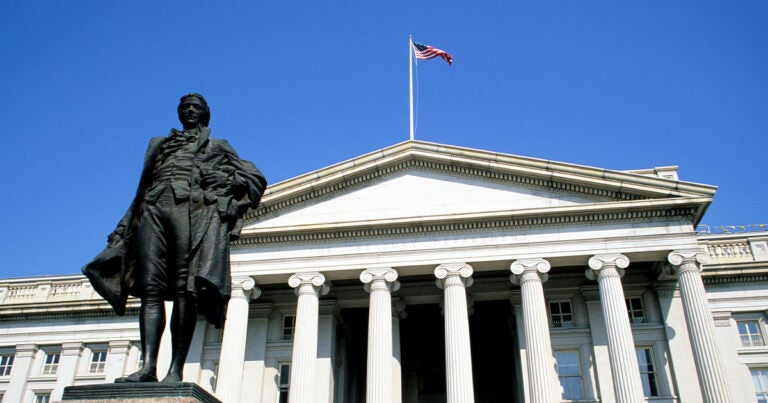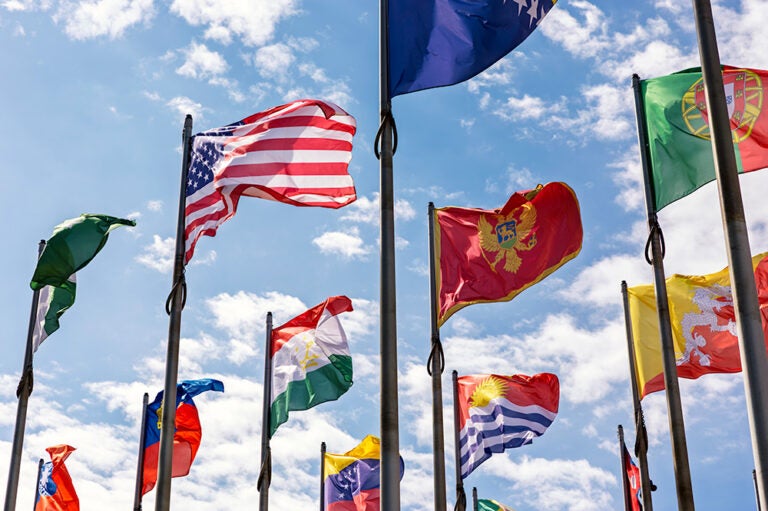Inflation affects many facets of the economy, from individual spending power to interest on the national debt. Pent-up demand, supply-chain issues, government spending, and the war in Ukraine pushed the annual rate of increase in consumer prices to 9.1 percent in June 2022, the highest rate in 40 years. However, actions by the Federal Reserve have helped tame the nation’s rising prices, with inflation bottoming out at 2.4 percent year over year in September 2024. Since then, such inflation has risen to 3.0 percent as of January 2025. Read on for an overview of inflation, how it is measured, why it matters, and how it can be addressed.
What Is Inflation and How Is It Measured?
Put simply, inflation is the rate at which prices for goods and services increase across an economy. (Deflation, on the other hand, refers to the general decline of such prices.) While some inflation is healthy — typically around a 2 percent annual increase in prices — a rapid growth or decline in prices can have negative effects on the economy.
The way in which inflation is measured is key to monitoring and managing it. Inflation is assessed through a price index, which tracks the change in prices for a basket of goods of services over time. Government agencies such as the Bureau of Labor Statistics (BLS) and the Bureau of Economic Analysis (BEA) produce a number of price indices to help policymakers, business leaders, and consumers track overall price movements.
Below are some of the most common price indices:
- Consumer Price Index (CPI) from the BLS tracks the average change over time in prices paid by urban consumers (many other CPI measures also exist). It is commonly used to adjust income eligibility for government assistance, provide cost-of-living adjustments to workers, and adjust benefits for programs such as Social Security.
- Personal Consumption Expenditures (PCE) Price Index from the BEA is the primary index used by the Federal Reserve to monitor inflation. Similar to the CPI, it also tracks prices paid by urban consumers, but the two indices differ in a number of ways; for example, the CPI only tracks out-of-pocket healthcare expenses paid by the consumer whereas the PCE also includes healthcare expenses paid through health insurance on behalf of the consumer.
- Producer Price Index (PPI) from the BLS measures the average change over time in the selling prices of goods produced in the United States. This index differs from the previous two in that the PPI looks at the prices paid by producers — such as prices for intermediate goods — whereas the CPI and PCE only look at the prices paid by the consumer for final products.
- Gross Domestic Product (GDP) Price Index also measures the change in prices paid for goods and services produced in the United States. The GDP price index differs from the PPI in that it includes the prices of goods exported to other countries but excludes imports (vice versa for PPI). The GDP price index is used to adjust economic activity, allowing for a year-to-year comparison of real (inflation-adjusted) GDP.
Some measures of inflation are calculated more narrowly as the change in prices for a specific set of goods and services or even a specific geographic area. Likewise, the change in prices is often reported on an annualized basis but is generally collected monthly.
When Has Inflation Occurred in the Past?
There have been several periods throughout the past several decades with high levels of inflation. In the late 1960s during the Vietnam War, low unemployment and strong economic growth pushed up wages — leading to an increase in prices. In the 1970s, high oil prices sparked expectations that other prices would also rise. Those high levels of inflation were brought down in the 1980s due to monetary policy decisions, such as drastically raising interest rates, to lower the amount of money in the economy. However, tackling those high levels of inflation was damaging to the U.S. economy — leading to higher levels of unemployment and two recessions in the early 1980s.
From the mid-1980s until 2020, inflation was low and relatively stable (with fluctuations around recessions). Even in the years before the onset of the COVID-19 pandemic, inflation remained relatively low despite high employment levels and strong economic growth — factors that economists previously thought of as strong influences on inflation. In 2022, however, inflation surged in the United States — reaching a 40-year high — due to high consumer demand, supply chain issues, government spending, and the war in Ukraine. Monetary policy decisions have helped tame those rising prices, as annual inflation has been gradually declining from the highs reached a couple of years ago. Inflation from January 2023 to January 2024 went down 3.3 percentage points to 3.1 percent, and continued to moderate to 2.4 percent in September 2024. More recently, inflation has risen and was measured at 3.0 percent in January 2025, sparking conversations about whether the trend will continue or move closer towards the Fed’s target of 2 percent.
What Causes Inflation?
There are several underlying factors that could cause prices to change. For instance, when the supply of money increases relative to the size of an economy — whether due to a surge in government spending or a central bank printing too much money — prices can rise. Likewise, events that raise production costs or disrupt the production of goods in the economy, such as wars or natural disasters, can also lead to an increase in prices. Both of those scenarios are examples of demand-pull inflation, a type of inflation that occurs when there’s too much money relative to the economy’s ability to produce goods and services.
Inflation can also occur when the price of input goods and services rise, known as cost-push inflation. When the cost of such goods rise, so too does the price of the final goods and services that use the input, thereby leading to inflation. An example of cost-push inflation is an oil shock, which can decrease the supply of oil — in turn increasing the price of oil as well as products across the economy where oil is a component.
Finally, inflation expectations — the rate at which consumers, businesses, and investors expect prices to rise — also affects inflation as such expectations may be built into wage negotiations and contractual price adjustments for future years. For example, if prices are expected to rise 2 percent annually, then businesses may want to raise the price of their goods by 2 percent and workers may request similar-sized wage increases.
The inverse of the causes noted above can also place downward, or deflationary, pressure on prices. Cheaper inputs, negative inflation expectations, and decreased demand for goods and services — especially during an economic recession — can all lead to a decline in prices.
The various drivers of inflation can also influence how long inflation persists. For example, an oil shock or a temporary increase in government spending may only lead to short-term bouts of inflation. On the other hand, sustained periods of increased government spending or excessive printing of money can lead to longer periods with high inflation and potentially hard-to-control “spirals” where price increases feed subsequent price increases.
How Does Inflation Affect Businesses and Consumers?
The rate at which prices change can have ramifications across the economy, affecting businesses and consumers alike. For instance, when high levels of inflation occur, the value of one’s money (also known as purchasing power) erodes, as consumers are no longer able to buy as much product with the same amount of money. Likewise, if wages do not rise at a similar rate as prices, inflation can devalue people’s wages and savings and increase the cost of living.
Changing prices can also create disparities across the economy by distorting the purchasing power for some individuals over time. An example is inflation’s effect on fixed interest payments. For instance, an individual with a fixed 3 percent yearly increase to their pension would lose purchasing power if inflation were higher than 3 percent, as the value of their pension would decline. On the other hand, someone with a fixed-rate mortgage of 3 percent would benefit from higher inflation as making those payments would become easier (assuming wages also rose with inflation).
Finally, inflation and deflation make it harder to anticipate how other aspects of the economy may change — such as interest rates, wages, taxes, and profits. That uncertainty could lead to less activity in the economy, such as businesses adjusting hiring decisions or households reducing their spending, and ultimately stunt economic growth.
What Are Some Options for Addressing Inflation?
The Federal Reserve can attempt to contain inflation through a number of monetary policy tools. To avoid the negative effects that rapidly changing prices can have on the economy, the central bank generally tries to maintain stability by keeping inflation (measured through the PCE Price Index) contained to around 2 percent annually. The Federal Reserve can utilize a number of policy tools to achieve that target inflation rate. For example, they can influence how much banks lend to consumers and businesses by changing the discount rate, which is the interest rate banks pay on loans from the Federal Reserve; they can also alter the amount of money banks are required to keep on hand (known as reserve requirements).
However, the most common method for the central bank to contain inflation is the federal funds rate — the interest rate that banks charge one another for overnight borrowing. The federal funds rate influences other interest rates that affect the borrowing costs for businesses and consumers. Therefore, when inflation is too high, the Federal Reserve can raise the federal funds rate to make borrowing more expensive — decreasing the supply of money to lower inflation. On the other hand, if inflation is too low, the central bank can lower that rate to stimulate the economy and move inflation higher. However, the fluctuation of interest rates can have other economic consequences as well — affecting financial markets, indebted organizations, and interest costs on the national debt.
Conclusion
The rate at which prices change can affect many facets of the economy — influencing people’s purchasing power, affecting economic growth, and raising or lowering interest costs on the national debt. Understanding and properly managing inflation is just one key element to promoting a healthy, sustainable economy.
Further Reading
The Fed Reduced the Short-Term Rate Again, but Interest Costs Remain High
High interest rates on U.S. Treasury securities increase the federal government’s borrowing costs.
What Types of Securities Does the Treasury Issue?
Let’s take a closer look at a few key characteristics of Treasury borrowing that can affect its budgetary cost.
Experts Identify Lessons from History for America Today
A distinguished group of experts to evaluate America’s current fiscal landscape with an historical perspective.


